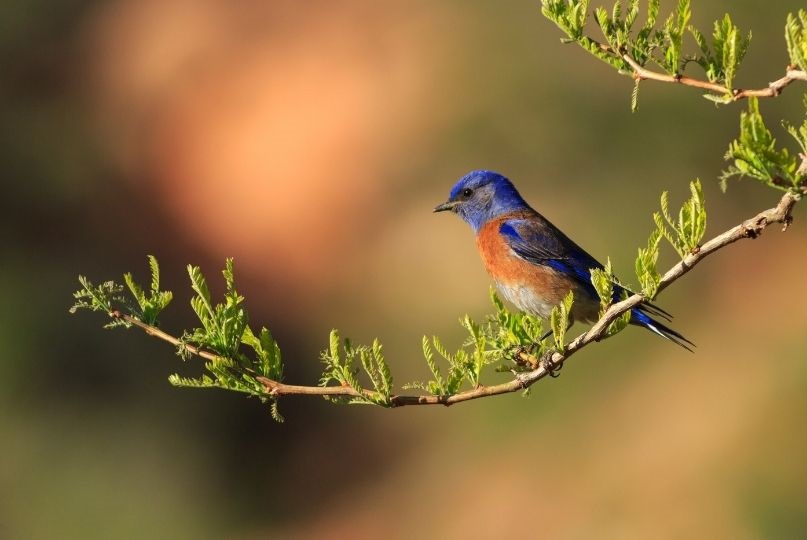All three types of Bluebirds have the same mating and nesting habits. And with the right conditions, they’ll soon welcome babies to their flock.
Though often mistaken for other bird species, finding a true Bluebird in your backyard feeder is a beautiful discovery. The gorgeous blue and orange bird is fun to watch and comes in three types of breeds.
Each of the three Bluebirds in North America looks almost identical, but you can tell which kind of Bluebird you have based on where you live.
The Eastern Bluebird ranges east of the Rocky Mountain and the Western Bluebird lives west of the Rocky Mountains. As its name suggests, the Mountain Bluebird lives exclusively in the Rockies.
Do Bluebirds Have a Mating Season?
The mating season begins in late February or early March in warmer southern climates.
Bluebirds leaving in the cooler climates of the north, or the mountainous regions, start their mating season in late March or early April. Regardless of when they start, all three types of Bluebirds’ mating season last around 83 days.
So, how do male and female bluebirds navigate mating season? And how can you tell the two apart?
Check our video to find out all about the way Bluebirds nest and lay eggs.
What Is the Difference Between a Male Bluebird and a Female Bluebird?
Telling a male and female Bluebird apart is relatively easy. Both have a distinctive orange chest and white belly with blue wing feathers. Like most birds, the male bluebird has strikingly bright plumage compared to the female.
A male Bluebird’s head, wings and back are a bright iridescent blue. The female also has blue on her head, wings and back, but the color is muted and almost gray.
The female also has less blue overall, with her main colors being beige, orange and white. The bluest feathers on a female bluebird are found mostly in her tail and a few feathers on her wings.
The color of their feathers isn’t the only difference between male and female Bluebirds. Their mating and parenting habits are vastly different, making for unique mating habits that aren’t shared by other songbirds.
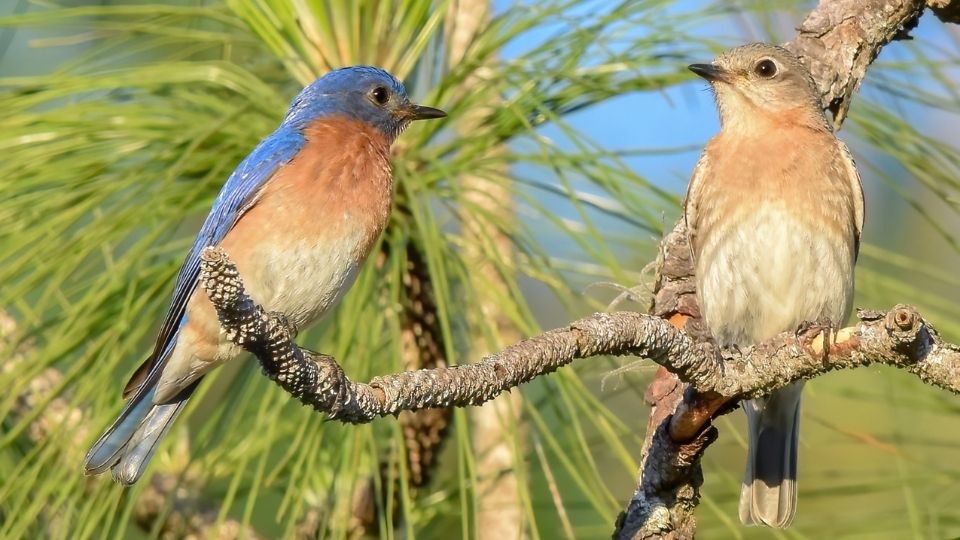
Do Bluebirds Mate for Life?
Like many songbirds, a pair of bluebirds do mate for life. But it’s more complicated than that.
Bluebirds have distinct mating practices. While many songbirds will work together building nests and caring for young, the male bluebird is far less involved.
The male Bluebird will present the female with nesting materials for building their nests, sometimes bringing colorful or shiny items to decorate the nest. But the actual building of the nest is up to the female.
Both male and female bluebirds will find a replacement mate if their mate disappears or dies. But for the most part, once bluebirds find a mate, the pair’s bond lasts for their entire life.
Watch our video to find out how to attract Bluebirds to your garden!
Do Bluebirds Stay Together as a Family?
Bluebirds also have distinctive parenting styles from other songbirds.
When hatchling Bluebirds are under 14 days old, the female Bluebird takes on 100% of the feeding and care duties. Female Bluebirds are known to leave the nest briefly in the early hours to eat, then return to the nest to devote their day to care for the nestlings. The male Bluebird spends the day near the nest, eating, singing and watching for predators.
After 14 days, the fledglings are largely able to feed themselves. At this point the male will sometimes feed the young. If the female disappears during this time, the male will step in and care for the young fulltime.
Once baby bluebirds leave the nest, the families flock together until the end of the summer.
In the fall, baby bluebirds split off and join other flocks.
Some Bluebirds return to the same nesting areas, while others do not. Only about 44% of bluebirds return to their nests yearly.
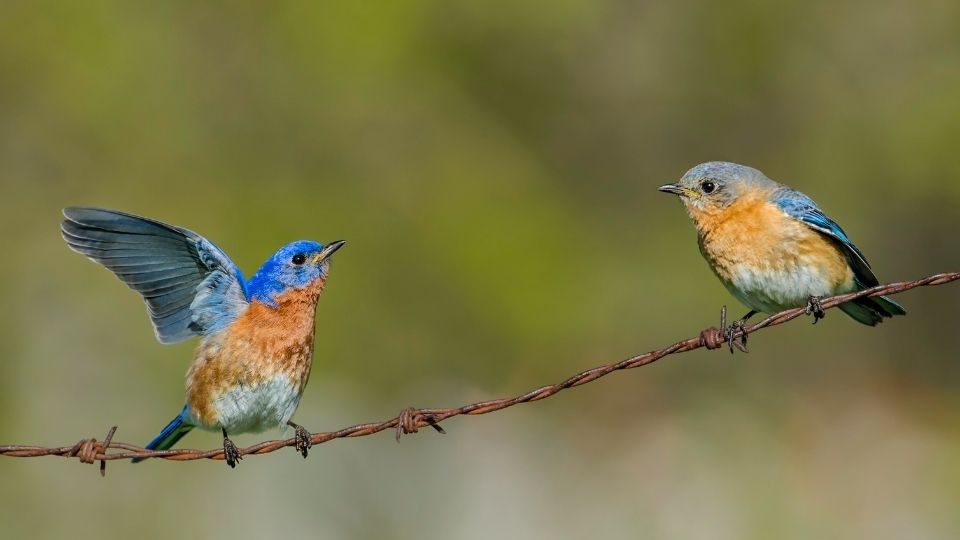
What Is the Lifespan of a Bluebird?
Bluebirds have a lifespan of 6 to 10 years. The oldest recorded Bluebird 10 years and 5 months, though that is very rare for these songbirds.
Most mortalities occur in the first year of life. Natural predators like snakes and racoons are known to eat unhatched eggs and hatchlings.
If the female bird leaves the nest in the first two weeks when hatchlings need the most care, they usually don’t survive. The male Bluebird is inattentive and ill-equipped to care for baby birds before fledgling age, when they are largely feeding themselves.
Despite all the challenges the bluebird must overcome in its first year of life, the number one threat to bluebirds is the outdoor cat.
Because Bluebirds prefer nests in tight spaces with a single entrance, they are easy targets for ambush, further shortening their lifespan.
In the video below, we discuss the meaning of crossing path with a Bluebird, whether in real life or your dreams.
Where do Bluebirds Build Their Nests?
Bluebirds are secondary cavity nesters, meaning they cannot create their own cavity but rely on natural cavities or those made by other birds.
Bluebirds can get very creative when choosing a location for their nests. Partially covered gutters, nesting boxes, tight spaces formed by broken tree branches, birdhouses, and even cavities formed by missing bricks in old buildings are all prime real estate to a Bluebird.
Of all the nesting options, Bluebirds prefer woodpecker holes by far. In 77% of cases, Bluebirds will nest in cavities that were previously excavated by woodpeckers.
Bluebirds are also known to be messy about nesting areas. Some will come back to the same nesting site, building on top of old nests without cleaning them.
Bluebirds will also build nests on top of old nests that weren’t theirs. Once breeding season is over, it’s best to clean the nest out if you’re using a nesting box or the nesting cavity was in your gutters, eaves etc.
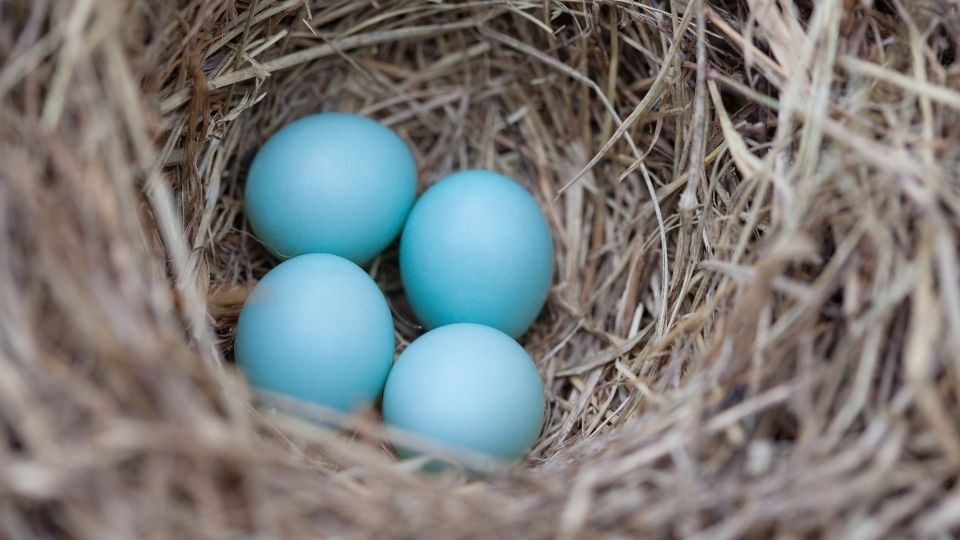
What Color Are Bluebird Eggs?
Bluebird eggs are known for their powder blue coloring. Small and smooth, the blue eggs have a light blue coating and no spotting like the eggs of the Blue Jay.
Occasionally, the eggs will be much lighter appearing white sometimes, with a tinge of blue or in some rare cases, pink!
Bluebird eggs are rarely white in color, only 7.1% in a controlled study appeared to brood pure white eggs.
Bluebirds only lay one color per clutch. For the most part, a bluebird that lays white eggs will always lay white eggs.
A Bluebird that lays pink eggs and blue eggs may alternate between the two colors and occasionally have a clutch of all white eggs.
All eggs in one clutch will be the same color but the next clutch can be a different color.
If you find a nest with different color eggs, another bluebird has laid her eggs in a shared nest.
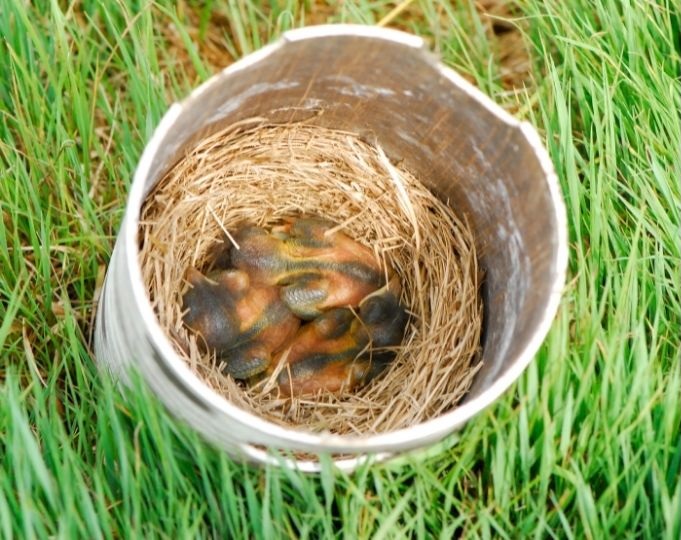
How Many Broods do Bluebirds Have per Mating Season?
Bluebirds spend 13 to 20 days incubating their eggs before hatching. Because the incubation time can vary by a full week, bluebirds tend to have one to two broods per season.
A shorter incubation period means they can lay more clutches–groups of eggs–so three broods isn’t out of the ordinary.
A mating pair with four to five broods in a single season is rare but happens. The female Bluebird will lay two to seven eggs per clutch, though four to five is the average.
About 83% of eggs successfully hatch according to studies on Bluebird nests.
If an entire clutch fails to hatch, the Bluebird pair will build a new nest on top of the failed clutch for their next brood.
If most of the eggs hatch, the Bluebirds will simply kick the failed eggs out if the growing hatchlings do not crush them.
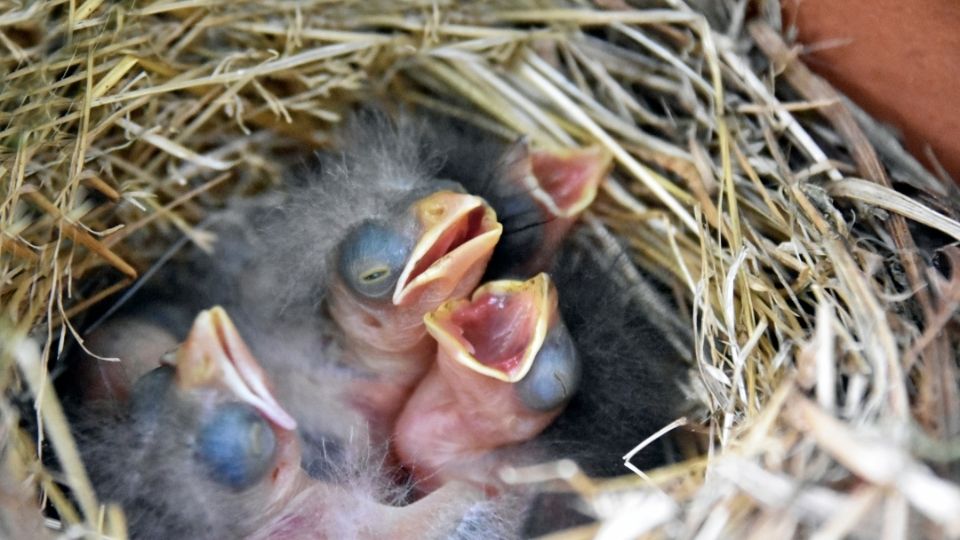
How Long do Baby Blue Birds Stay in the Nest?
Baby bluebirds stay in the nest 17-21 days. Unlike a lot of birds, baby bluebirds are jumpy and prone to being startled by about 14 days after hatching. After this age, viewing the babies should be done from a distance with binoculars
They start leaving the nest in short bursts for the first time with their parents at 16/17 days old and leave for good no later than 22 days old.
Since Bluebirds can mate the first summer after they are hatched, they can lay eggs near the end of their first year.

